|
|
|
Sort Order |
|
|
|
Items / Page
|
|
|
|
|
|
|
| Srl | Item |
| 1 |
ID:
170974
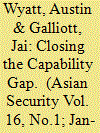

|
|
|
|
|
| Summary/Abstract |
The procurement of autonomous weapon systems is on the rise in Southeast Asia, where, as in other parts of the world, interest in the military applications of unmanned systems is outpacing fractured international regulation efforts. This article analyzes the diffusion of drone technology in Southeast Asia and argues that we are at an inflection point, representing an opportunity for The Association of Southeast Asian Nations (ASEAN) to control the diffusion of unmanned platforms and take a leadership role in developing a regionally appropriate framework for their development. Moreover, it contends that with a regional framework in place to reduce tensions/misadventure, unmanned aerial and maritime vehicles (UAVs & UMVs) could improve ASEAN’s ability to respond to traditional and non-traditional security threats, and thus increase regional security.
|
|
|
|
|
|
|
|
|
|
|
|
|
|
|
|
| 2 |
ID:
130667
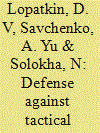

|
|
|
|
|
| Publication |
2014.
|
| Summary/Abstract |
The article focuses on tactical unmanned aerial vehicles (UAVs) and the need to develop an effective defense against drone attacks. Existing weapons and ways to defend against drones are presented. Problems discussed include challenges in detecting and destroying small size UAV's or drones. Options for defending against tactical drones including the use of laser as weapon, powerful electromagnetic impulses that disable drone equipment and drone hunter-killers are also presented.
|
|
|
|
|
|
|
|
|
|
|
|
|
|
|
|
| 3 |
ID:
136750
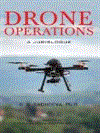

|
|
|
|
|
| Publication |
New Delhi, KW Publishers Pvt Ltd, 2015.
|
| Description |
xiv, 202p.Hbk
|
| Standard Number |
9789383649440
|
|
|
|
|
|
|
|
|
|
|
|
Copies: C:2/I:0,R:0,Q:0
Circulation
| Accession# | Call# | Current Location | Status | Policy | Location |
| 058123 | 623.7469/SAC 058123 | Main | On Shelf | General | |
| 058188 | 623.7469/SAC 058188 | Main | On Shelf | General | |
|
|
|
|
| 4 |
ID:
130342


|
|
|
|
|
| Publication |
2014.
|
| Summary/Abstract |
As the U.S. government winds up an interagency review of rules governing the export of large drones, the conflicting goals of nonproliferation and commerce are creating a new test of the 27-year-old Missile Technology Control Regime (MTCR). Observers do not expect big changes to the MTCR, which seeks to prevent the proliferation of unmanned systems capable of delivering weapons of mass destruction. The MTCR, a voluntary arrangement that now includes 34 countries, originally was intended to curb the spread of ballistic missiles and unmanned vehicles capable of carrying nuclear weapons. In 1993 it was amended to control systems carrying any weapons of mass destruction. It has become Washington's chief tool for controlling the spread of armed drones. "It's quite unlikely that we will see any radical change in the MTCR," Eric McClafferty, an attorney at Kelley Drye and Warren, a law firm in Washington that represents UAV manufacturers, said in a March 19 interview. "That said, there's a lot of pressure on the U.S. government to liberalize controls to make sure the U.S. doesn't get left behind in this market." The conflict has played out in a series of closed-door meetings over the last two months among the State, Defense, and Commerce departments as officials seek to update U.S. policy toward the burgeoning UAV market. Industry representatives have made their views known via technical committees that advise policymakers in these departments. "It's a pretty contentious fight" between the State Department's Bureau of International Security and Nonproliferation and the Pentagon's Defense Technology Security Administration, said Micah Zenko, a fellow at the Council on Foreign Relations, in a March 17 interview. The State Department says that "if you pull at the thread of MTCR, you will weaken the nonproliferation regime as a whole. The other side says the international market is going to supply these UAVs anyway," Zenko said. The heart of the issue is what kind of UAVs U.S. manufacturers can sell overseas. The MTCR imposes a "presumption of denial" for the export of so-called Category 1 UAV's, which are drones that can travel more than 300 kilometers with a payload of more than 500 kilograms. Drones that do not have those capabilities are classified as Category 2 UAVs and are not subject to such restrictive criteria. Two drones currently classified as Category 1-the Reaper, formerly known as the Predator, and the Global Hawk-have played a central role in U.S. aerial attacks on suspected Islamic militants in Pakistan, Somalia, and Yemen. Washington has approved the sale of an armed drone to only one country, the United Kingdom, although unarmed versions of these drones have been sold to Italy and South Korea.
The stakes of the MTCR review process are large politically and economically, observers say.
|
|
|
|
|
|
|
|
|
|
|
|
|
|
|
|
| 5 |
ID:
130676
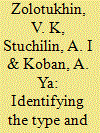

|
|
|
|
|
| Publication |
2014.
|
| Summary/Abstract |
The article discusses procedures for identifying the type and nationality of aerial vehicles to enhance effectiveness of airspace control during conflict situations. Capabilities of optoelectronic devices to gather information on class and type of aircraft are discussed. Images from a combination of optical detection instruments and radar obtained through experimental observations are presented to illustrate improvements possible to the image quality.
|
|
|
|
|
|
|
|
|
|
|
|
|
|
|
|
| 6 |
ID:
072573
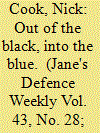

|
|
|
| 7 |
ID:
130957
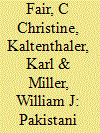

|
|
|
|
|
| Publication |
2014.
|
| Summary/Abstract |
America's Employment of Weaponized Unmanned Aerial Vehicles (Uavs), Popularly Known as "drones," to kill alleged terrorists in Pakistan's federally administered tribal areas (FATA) fuels sustained controversy in Pakistan. Pakistani outrage has steadily deepened since 2008, when the United States increased the frequency of the strikes.1 The increasing use of "signature strikes" has been particularly controversial in (and beyond) Pakistan, because such strikes are targeted at "men believed to be militants associated with terrorist groups, but whose identities aren't always known."2 Whereas personality strikes require the operator to develop a high level of certainty about the target's identity and location, based on multiple sources such as "imagery, cell phone intercepts and informants on the ground,"3 operators may "initiate a signature strike after observing certain patterns of behavior."4 When conducting signature strikes, the United States assesses that the individuals in question exhibit behaviors that match a pre-identified "signature" (for example, pattern of observable activities and/or personal networks) that suggests that they are associated with al Qaeda and/or the Pakistani or Afghan Taliban organizations.5 Because the identity of the target is unknown, even during the strike, it is possible that these persons are innocent civilians, a possibility that both current and former U.S. government officials concede.6 While the George W. Bush administration employed both personality strikes from 2004 and signature strikes from 2008 in Pakistan, the administration of Barack Obama has redoubled the use of both types.7 This has ignited public protests against the drones in Pakistan, particularly in Pakistan's urban areas-far removed from the tribal areas where drones are employed. It has also galvanized a vigorous debate within Pakistan's National Assembly, which tried, but ultimately failed, to curtail the strikes
|
|
|
|
|
|
|
|
|
|
|
|
|
|
|
|
| 8 |
ID:
102308
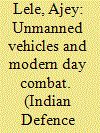

|
|
|
| 9 |
ID:
151941
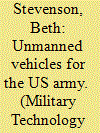

|
|
|
|
|
|
|
|